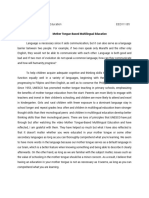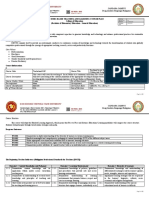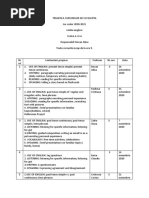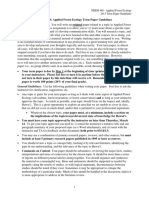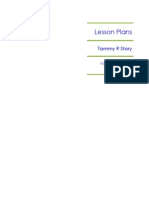0 ratings0% found this document useful (0 votes)
267 viewsELED-107-Module Unit-I-Lesson-2
This document provides an overview of a lesson on constructivist theory in teaching mathematics in intermediate grades. It discusses key aspects of constructivism such as knowledge being constructed from experiences rather than direct instruction. The lesson teaches how constructivism applies to math education by building on prior knowledge and allowing students to form their own understandings through problem posing and authentic assessment. Students are asked critical thinking questions to assess their understanding of constructivism and how it relates to math, as well as potential challenges of the theory.
Uploaded by
ethan philasiaCopyright
© © All Rights Reserved
Available Formats
Download as PDF, TXT or read online on Scribd
0 ratings0% found this document useful (0 votes)
267 viewsELED-107-Module Unit-I-Lesson-2
This document provides an overview of a lesson on constructivist theory in teaching mathematics in intermediate grades. It discusses key aspects of constructivism such as knowledge being constructed from experiences rather than direct instruction. The lesson teaches how constructivism applies to math education by building on prior knowledge and allowing students to form their own understandings through problem posing and authentic assessment. Students are asked critical thinking questions to assess their understanding of constructivism and how it relates to math, as well as potential challenges of the theory.
Uploaded by
ethan philasiaCopyright
© © All Rights Reserved
Available Formats
Download as PDF, TXT or read online on Scribd
You are on page 1/ 4
MARIANO MARCOS STATE UNIVERSITY
UNIVERSITY
College of Teacher Education
Lesson Title Unit I – The Mathematics Curriculum in the Intermediate Grades
Lesson II – Constructivist Theory in Teaching Mathematics in the
Intermediate Grades
Prepared by Prof. Roselia A. Borromeo
Introduction DepED (2016) specifically noted constructivist theory as the backbone
of the curriculum. According to DepED, knowledge is constructed when
the learner is able to draw ideas from his/her own experiences and
connect them to new ideas. In this lesson, you will learn about the
constructivist learning theory and how it is applied in teaching
mathematics in the intermediate grades.
Learning Outcomes • Demonstrate understanding and appreciation of the
constructivist learning theory.
• Determine how the constructivist learning theory is applied in
teaching mathematics in the early grades.
Think Constructivism was conceptualized by educational theorist Jean Piaget.
Do you remember him from your psychology classes? Piaget believed
that young children learn by constructing knowledge from experiences
rather than from adults telling them about the world. According to
Piaget and others who practice constructivist education, the method
that is most likely to educate the students is the one in which they
experience the world. Constructivism is approximately applied in the
teaching mathematics since Math is cumulative and vertically
structured discipline. One learns new math by building on the math that
has been previously learned.
Constructivism learning is described as follows:
• Learning builds on the learner’s prior knowledge and the
approach is a constructive process.
• Learner is involved in the processes to ensure self-regulated and
self-directed process.
• Learning is grounded in the context of the learners and
fundamentally social process. Interaction and communication
are open and basic elements of learning process.
Castro Ave., Laoag City, 2900 Ilocos Norte, Philippines
cte@mmsu.edu.ph (077) 600-2014 www.mmsu.edu.ph
MARIANO MARCOS STATE UNIVERSITY
UNIVERSITY
College of Teacher Education
• Learning is more than the acquisition of knowledge. It is
collaborative, involves interaction and enculturation with
community of practitioners. Collaboration with experts is basic.
• The learning process do not only require cognitive but also
motivational and emotional domains.
Experience In a constructivist mathematics class, knowledge is constructed by the
learners. To teach is not to explain, not to lecture, not to transfer
mathematical knowledge; instead teaching is to create situations that
allow the learners to form the mental construction. The following are
some recommendations on how to apply constructivism in teaching
mathematics.
• Pose problems that are relevant to the learners;
• Use big concepts than segmented or disjoint topics. It invites
the learners to participate irrespective of learning styles and
dispositions;
• Create situations that will reveal the learner’s point of view.
The teacher must create opportunities for this occur and must
be willing to listen to the learner’s reasoning and thinking
processes; and
• Use authentic assessments, which includes interaction
between the teacher and learner and peer.
Assess Answer the following questions to verbalize your understanding of
constructivist learning theory.
1. What is the constructivist theory? Explain it in your own words.
____________________________________________________
____________________________________________________
____________________________________________________
____________________________________________________
____________________________________________________
2. Expound why the constructivist theory is applicable in teaching
mathematics.
Castro Ave., Laoag City, 2900 Ilocos Norte, Philippines
cte@mmsu.edu.ph (077) 600-2014 www.mmsu.edu.ph
MARIANO MARCOS STATE UNIVERSITY
UNIVERSITY
College of Teacher Education
____________________________________________________
____________________________________________________
____________________________________________________
____________________________________________________
____________________________________________________
Challenge There is no perfect theory. The following questions will challenge your
critical thinking skills as they raise criticisms on the constructivist
learning theory.
1. What do you think could be the possible challenges in using
constructivism in teaching mathematics?
____________________________________________________
____________________________________________________
____________________________________________________
____________________________________________________
____________________________________________________
2. What other learning theories could be implemented in teaching
math that could complement the down sides of constructivism?
____________________________________________________
____________________________________________________
____________________________________________________
____________________________________________________
____________________________________________________
Harness The next activity will expose you to an actual mathematics class. You
will do numerous classroom observations throughout this module. In
this activity, direct your observation skills to the teaching style of the
teacher. Note that this is not an activity to criticize the teacher. The
purpose is for you to develop keen observation skills on teaching styles
implemented in the classroom and later suggest ways to improve the
learning activities, This activity will be part of the learning portfolio that
you will compile at the end of this module.
Observe a Grade 6 mathematics class. Did the lesson develop in a
constructive way? If yes, describe the part of the lesson that followed
constructivism. Otherwise, explain how you would revise the lesson in
order to facilitate a constructivist lesson.
Castro Ave., Laoag City, 2900 Ilocos Norte, Philippines
cte@mmsu.edu.ph (077) 600-2014 www.mmsu.edu.ph
MARIANO MARCOS STATE UNIVERSITY
UNIVERSITY
College of Teacher Education
____________________________________________________
____________________________________________________
____________________________________________________
____________________________________________________
____________________________________________________
____________________________________________________
____________________________________________________
____________________________________________________
____________________________________________________
____________________________________________________
Summary The constructivist learning theory states that learning takes place when
we build on what the students already know. Moreover, it is student-
centered, allowing the students to take ownership of their own
learning.
Castro Ave., Laoag City, 2900 Ilocos Norte, Philippines
cte@mmsu.edu.ph (077) 600-2014 www.mmsu.edu.ph
You might also like
- 1 - Introduction To Marketing Communications and IMC100% (3)1 - Introduction To Marketing Communications and IMC29 pages
- Curriculum Development Module 3 Foundations of Curriculum DevelopmentNo ratings yetCurriculum Development Module 3 Foundations of Curriculum Development3 pages
- Weebly Intercultural Communication Lesson Plan100% (1)Weebly Intercultural Communication Lesson Plan14 pages
- Module Number 18 - Traditional AssessmentNo ratings yetModule Number 18 - Traditional Assessment2 pages
- Teaching Arts in The Elementary Grades: OgdimalantaNo ratings yetTeaching Arts in The Elementary Grades: Ogdimalanta8 pages
- Module 6 Lesson 1B Learning To Live TogetherNo ratings yetModule 6 Lesson 1B Learning To Live Together8 pages
- "What A Child Can Do in Cooperation Today, Tomorrow She/he Will Be Able To Do Alone". - Lev VygotskyNo ratings yet"What A Child Can Do in Cooperation Today, Tomorrow She/he Will Be Able To Do Alone". - Lev Vygotsky4 pages
- Module 1-The Teacher and The School CurriculumNo ratings yetModule 1-The Teacher and The School Curriculum19 pages
- Common Illnesses and Injuries: Study Guide For Module No. 5No ratings yetCommon Illnesses and Injuries: Study Guide For Module No. 512 pages
- Storytelling-and-other-cultural-strategiesNo ratings yetStorytelling-and-other-cultural-strategies18 pages
- Lesson 3: Competencies of An Art TeacherNo ratings yetLesson 3: Competencies of An Art Teacher2 pages
- Considered The Conditions Under Which Multi-Grade Teaching Becomes A NecessityNo ratings yetConsidered The Conditions Under Which Multi-Grade Teaching Becomes A Necessity3 pages
- Chapter 3 Lesson 4 Managing Students Behavior Canlas Patricia R. Beed3cNo ratings yetChapter 3 Lesson 4 Managing Students Behavior Canlas Patricia R. Beed3c23 pages
- Educ 18 - Social Science Theories and Their Implications To Education Lesson PlanNo ratings yetEduc 18 - Social Science Theories and Their Implications To Education Lesson Plan11 pages
- Conceptual Framework and Theoretical BasisNo ratings yetConceptual Framework and Theoretical Basis13 pages
- Lesson 3 - Approaches in Teaching LiteratureNo ratings yetLesson 3 - Approaches in Teaching Literature12 pages
- Q1 - LE - PE and Health 7 - Lesson 3 - Weeks 4-6No ratings yetQ1 - LE - PE and Health 7 - Lesson 3 - Weeks 4-611 pages
- effective approaches in teaching literatureNo ratings yeteffective approaches in teaching literature58 pages
- Reviewer For Assessment in Learning - GonzalesNo ratings yetReviewer For Assessment in Learning - Gonzales17 pages
- UNIT III, LESSON 2 - USING GRAPHIC ORGANIZERSNo ratings yetUNIT III, LESSON 2 - USING GRAPHIC ORGANIZERS9 pages
- Learning Competencies (Grade1 - Grade 3)No ratings yetLearning Competencies (Grade1 - Grade 3)9 pages
- PE04 Learning Material 2 Unit 1-2 Topics:: Answer BrieflyNo ratings yetPE04 Learning Material 2 Unit 1-2 Topics:: Answer Briefly2 pages
- Instructions Computing Judging Scores in Excel PDFNo ratings yetInstructions Computing Judging Scores in Excel PDF2 pages
- Test Yourself: "I" (My Individual Identity) "Me" (Others Expectation of ME)No ratings yetTest Yourself: "I" (My Individual Identity) "Me" (Others Expectation of ME)2 pages
- Underside of Philippine History: Pasyon Interface100% (1)Underside of Philippine History: Pasyon Interface7 pages
- Starting A Small Business: Fundamentals of Management MAGT 121No ratings yetStarting A Small Business: Fundamentals of Management MAGT 1219 pages
- Shanto-Mariam University of Creative TechnologyNo ratings yetShanto-Mariam University of Creative Technology19 pages
- 14 Sales Strategies To Increase Sales and RevenueNo ratings yet14 Sales Strategies To Increase Sales and Revenue4 pages
- Anood Alshehhi h00249845 - MCT Lesson Observation Report - Lesson 1No ratings yetAnood Alshehhi h00249845 - MCT Lesson Observation Report - Lesson 12 pages
- Objective 5: Managed Learner Behavior Constructively by Applying Positive and Non-Violent Discipline To Ensure Learning Focused Environments100% (1)Objective 5: Managed Learner Behavior Constructively by Applying Positive and Non-Violent Discipline To Ensure Learning Focused Environments1 page
- The Use of Diary Writing To Improve Writing Skill in Recount TextNo ratings yetThe Use of Diary Writing To Improve Writing Skill in Recount Text34 pages
- SITXCOM010 Customer Service Policy and ProceduresNo ratings yetSITXCOM010 Customer Service Policy and Procedures4 pages
- Marketing Mix, Not Branding:, IncludingNo ratings yetMarketing Mix, Not Branding:, Including11 pages
- Lesson 4.1 Learning Management Systems: (LMS) : 4.1.1 General DescriptionNo ratings yetLesson 4.1 Learning Management Systems: (LMS) : 4.1.1 General Description5 pages
- 1 - Introduction To Marketing Communications and IMC1 - Introduction To Marketing Communications and IMC
- Curriculum Development Module 3 Foundations of Curriculum DevelopmentCurriculum Development Module 3 Foundations of Curriculum Development
- Teaching Arts in The Elementary Grades: OgdimalantaTeaching Arts in The Elementary Grades: Ogdimalanta
- "What A Child Can Do in Cooperation Today, Tomorrow She/he Will Be Able To Do Alone". - Lev Vygotsky"What A Child Can Do in Cooperation Today, Tomorrow She/he Will Be Able To Do Alone". - Lev Vygotsky
- Common Illnesses and Injuries: Study Guide For Module No. 5Common Illnesses and Injuries: Study Guide For Module No. 5
- Considered The Conditions Under Which Multi-Grade Teaching Becomes A NecessityConsidered The Conditions Under Which Multi-Grade Teaching Becomes A Necessity
- Chapter 3 Lesson 4 Managing Students Behavior Canlas Patricia R. Beed3cChapter 3 Lesson 4 Managing Students Behavior Canlas Patricia R. Beed3c
- Educ 18 - Social Science Theories and Their Implications To Education Lesson PlanEduc 18 - Social Science Theories and Their Implications To Education Lesson Plan
- PE04 Learning Material 2 Unit 1-2 Topics:: Answer BrieflyPE04 Learning Material 2 Unit 1-2 Topics:: Answer Briefly
- Instructions Computing Judging Scores in Excel PDFInstructions Computing Judging Scores in Excel PDF
- Test Yourself: "I" (My Individual Identity) "Me" (Others Expectation of ME)Test Yourself: "I" (My Individual Identity) "Me" (Others Expectation of ME)
- Starting A Small Business: Fundamentals of Management MAGT 121Starting A Small Business: Fundamentals of Management MAGT 121
- Anood Alshehhi h00249845 - MCT Lesson Observation Report - Lesson 1Anood Alshehhi h00249845 - MCT Lesson Observation Report - Lesson 1
- Objective 5: Managed Learner Behavior Constructively by Applying Positive and Non-Violent Discipline To Ensure Learning Focused EnvironmentsObjective 5: Managed Learner Behavior Constructively by Applying Positive and Non-Violent Discipline To Ensure Learning Focused Environments
- The Use of Diary Writing To Improve Writing Skill in Recount TextThe Use of Diary Writing To Improve Writing Skill in Recount Text
- Lesson 4.1 Learning Management Systems: (LMS) : 4.1.1 General DescriptionLesson 4.1 Learning Management Systems: (LMS) : 4.1.1 General Description







